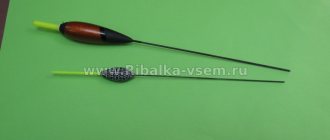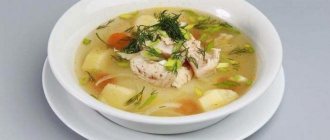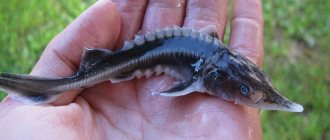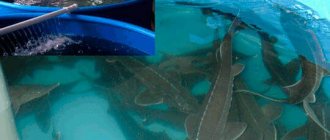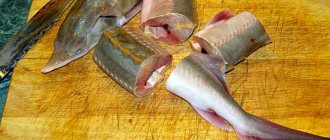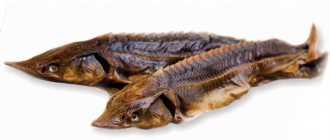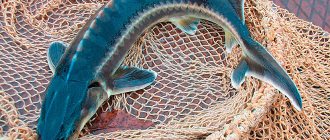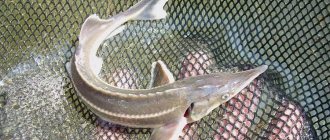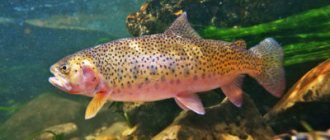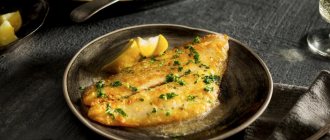What is the difference?
How do sturgeon and sterlet differ in appearance? Differences in magnitude are the first main criterion. Sterlet is considered the smallest in this family. In average individuals, the length can be up to sixty centimeters. They weigh from one to two kilograms. Male sterlet matures early. They go to spawn at about five years old, and females a little later: at seven or eight years old. The value of this commercial fish is undeniable. It can be bred in ponds and lakes. The record weight reaches 16 kg. Sturgeons are usually distinguished by the fact that they are larger and can weigh up to 100 kilograms, their length is about 5 meters.
In addition to length and weight, a number of characteristics of these two breeds are given below:
- The sterlet's head has a narrower shape and a long, thin nose. In addition, she has a mustache in the form of a fringe.
- A characteristic feature of sturgeon is the presence of scutes instead of scales, which differ in number. On the back of the sterlet there are spines that come out of the bony scutes, there are 70 of them in total. The sturgeon has 58 of them.
- Before spawning, sturgeon live in the sea, and only during the period when it is necessary to take care of the offspring, the fish go out into fresh waters - these are migratory fish. But sterlet is characterized by sedentism, unlike sturgeon.
- Sturgeon has a dry taste, and the fat content of sterlet is slightly higher, it is 30% versus fifteen for sturgeon. The delicate and delicate taste of sterlet was appreciated by all gourmets.
- These two subspecies differ even in their caviar. Due to the small size of the sterlet, the caviar in it is much less than that of the sturgeon. Its size is almost like beads and the color is more saturated.
So, we know the main differences between the two fish: all zoological reference books almost unanimously state that sturgeon is a genus of fish within the sturgeon family. The sterlet is included in this subgroup. Characteristic features: a narrow head and a long pointed nose, the presence of fringed antennae and a large number of spines on the back - these are a number of the main differences. The weight and dimensions are significantly smaller than those of other sturgeons. In addition, the sturgeon is more mobile than the sterlet. She is a homebody and leads a sedentary lifestyle and does not wander from freshwater to sea. Sterlet has fatty meat and a delicate taste.
Sturgeon fish dishes will decorate any table. The most valuable sterlet dish is rich fish soup and aspic. Sturgeon or sterlet, whichever you prefer, choose for yourself. Both of these options can decorate any table.
Sterlet
Everything that has been said about the appearance of the sturgeon can be repeated when talking about the appearance of the sterlet: its body has the same spindle-shaped shape; it is also covered with rows of scutes; she has the same (cone) head, with a transverse mouth located below; the same gray-yellow-brown color of her body. Nevertheless, it is impossible to confuse sterlet even with a young sturgeon.

It has its own distinctive features. For example, the nose is much longer and sharper than that of the sturgeon. The antennae under the snout are also longer, and they have the appearance of a fringe. The scutes on the back of the sterlet are equipped with sharp spines, which the sturgeon does not have, and the side scutes are in contact with each other and there are much more of them - up to 70 pieces. And in general, the sterlet has a different appearance, it is much slimmer than the sturgeon.
But the main difference is the size. Sterlet is the smallest fish of the sturgeon family. It is rarely more than a meter long and weighs 10-12 kg. In our reservoirs, even specimens weighing 3-5 kg are rare.
- Sterlet differs from other sturgeons in its smallest size.
- It has a small, narrow head.
- The sterlet's nose is longer and narrower than that of other sturgeons. Her antennae are fringed and quite long.
- There are more side bugs (up to 70 pieces) and there are sharp spikes on the back.
- Sterlet is a sedentary fish.
- The meat is fattier and more tender than other sturgeon.
Sturgeon has a dry taste, and the fat content of sterlet is slightly higher, it is 30% versus fifteen for sturgeon. The delicate and delicate taste of sterlet was appreciated by all gourmets.
These two subspecies differ even in their caviar. Due to the small size of the sterlet, the caviar in it is much less than that of the sturgeon. Its size is almost like beads and the color is more saturated.
Sturgeon species
The most famous types of sturgeon fish are:
Among the record holders of this family there were specimens about three meters long and weighing about two centners. The largest among the sisters is the beluga. Unique specimens are known whose length reaches four meters and weighs one ton. Beluga can be considered one of the largest fish on the planet.
Sturgeons feed mainly on animal food. These are worms, mollusks, insects. They do not disdain smaller fish either. Thus, this family can be classified as predators.
Once upon a time, sturgeon species lived in large numbers in the waters of the Volga and other rivers of Russia. Now the modern environmental situation threatens the existence of many valuable fish species. Sturgeon are no exception. Some species are on the verge of extinction, so the state is strengthening measures to combat poaching.
Artificial breeding and cultivation
Sterlet aquaculture is widely developed in special cage farms, which consist of a number of pools or are located in open and enclosed reservoirs. The main condition for successful sturgeon keeping is good aeration, which allows you to saturate the water with oxygen to a level of 5 mg/l or more. It is necessary to maintain the optimal temperature regime of the environment +18-24°C, since in very cool water bodies (below +1-2°C) fish begin to die en masse.
Advanced cage farms use special equipment that allows not only to settle, enrich with oxygen, disinfect and, if necessary, heat water, but also to organize its mechanical and biological treatment for reuse and cost reduction. The greatest difficulties in artificial breeding of sterlet are associated with accustoming the fish to feeding on compound feed. With the correct organization of the process, in just 9-10 months you can “translate” a tiny fry weighing 5-7 g into a sought-after product category with a net weight of 400-500 g.
To learn more:
Description of the chub - a large fish of the carp family

Hybrid forms of sturgeon
Beluga and kaluga are considered the largest of their freshwater relatives. These migratory fish live for a very long time, sometimes the age of some centenarians reaches one hundred years.
The following subspecies are hybrid forms:
- beluga and sterlet (bester);
- sturgeon and beluga;
- beluga and thorn;
- sturgeon and beluga.
These hybrids are mainly inhabitants of the Sea of Azov, and are sometimes found in some reservoirs.
Beluga flesh is a little coarser, but very suitable for making balyk. The best black caviar comes from this representative.
The hybrid obtained by crossing beluga and sterlet is called bester. This species is in great consumer demand due to its dietary properties. It is also a delicacy because it attracts those who want to try an extremely amazing-tasting product due to its visual appeal and aesthetics. The taste of caviar is in no way inferior to beluga caviar.
Related species
Despite the fairly large diversity of representatives of the family (dozens of types of sturgeon, stellate sturgeon, thorn, kaluga), all species are biologically very close and allow the formation of unique hybrids.
In 1952, a bester was bred in the USSR, whose name consists of the first syllables of the name of the “parents” - the largest generic taxon of Beluga (Huso huso) and the smallest - Sterlet.
This fish is characterized by tolerance to salt water (up to 18%) and a sharp contrast between the gray-brown or brown back and light belly. The original hybrid incorporated the accelerated growth of beluga and the rapid maturation of sterlet. The maximum weight of a bester reaches 28-30 kg with a body length of 170-180 cm. But these figures can be doubled subject to further crossing with the pure form of Huso huso - the beluga bester. In the basins of the Irtysh, Ob, Yenisei, Angara, Sayano-Shushenskoye and Krasnoyarsk reservoirs, a special subspecies of sturgeon lives - the Siberian sterlet (Acipenser ruthenus marsiglii). This taxon differs from the basic form by late maturation, lighter color and the ability to gain weight over 20 kg.
To learn more:
What is bleak and where does it live?
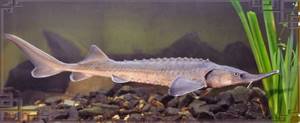
How to distinguish sterlet from sturgeon
The sturgeon genus has existed on planet Earth for many millennia and belongs to the elite class of commercial fish. Gourmet dishes for the preparation of which sturgeon was used were at all times considered a decoration for the festive tables of pharaohs, kings, and emperors. Sterlet and sturgeon are considered the most famous varieties of this delicious fish among modern consumers. Both representatives of sturgeon belong to the same family, but have a certain list of differences in appearance and taste.
There are other signs that help to understand how sterlet differs from sturgeon. The main difference between two outwardly similar representatives of the same genus of fish, from a zoological point of view, is their official classification.
It is customary to call 19 names of fish of the sturgeon family sturgeon (the most famous are beluga, thorn, stellate sturgeon), and sterlet is one of the species of this family.
How to cook sterlet
All chefs know the fact that sterlet will hide any mistakes of an inept cook. Therefore, it is practically impossible to spoil dishes that use fish.
But there are basic rules when cooking that are prohibited from breaking:
- The sterlet must be carefully gutted.
- Using a sharp knife, cut off the dorsal and lateral growths (the so-called beetles).
- The skin may not be removed, no matter how tough it may be (the skin can be easily removed from a cooked dish).
- It is mandatory to remove a white vein that runs along the entire spine of the fish (it is also called a vizig). For this purpose, cuts are made near the head and tail. Then the vein simply stretches out.
- It is important to rinse the sterlet thoroughly under running water.
- Due to the fact that sterlet belongs to the smallest varieties of the sturgeon group, the length of the carcass does not exceed half a meter and two kilograms of weight. Some may find these sizes unacceptable, but they are just right for the kitchen.
Is it possible to eat sterlet raw?
Eating raw sterlet is common for the local population where this fish is found. Somewhat salted and peppered raw fish meat is often called “Russian sushi fish”.
So, meat “poached” in salt and ground black or allspice, cut into pieces, often becomes a component of vegetable salads (fish becomes a substitute for animal meat and sausage).
Cooking steamed and boiled sterlet
If you want to boil sterlet for soup or fish soup, not only the fish itself is placed in water (1.5 liters), but also various herbs and roots are added (it is better to take fresh garlic and onions, as well as sweet peas). It is recommended to cook sterlet for approximately 15 minutes from the moment of boiling (this time is quite enough). If you are preparing exclusively fish soup (when you do not plan to stuff the fish), you should put only parsley and dill roots in the water (according to the classic recipe of the 19th century).
How to fry sterlet
Like any other fish, sterlet is rarely fried. To do this, small pieces of fillet are pre-breaded in breadcrumbs. Only then are they fried in a hot frying pan with vegetable oil. Still, they should be ready in the oven on a baking sheet (approximate time - 8 minutes).
When the pieces are large, you will have to:
- First, steam them;
- Dry on a paper towel;
- Dip in egg batter and breadcrumbs;
- Fry in vegetable oil.
Although the best option for frying is considered “dry”, which occurs on a spit or grill (here you need to cut the fish in half along the ridge line, pepper and salt it, and also sprinkle with white wine or lemon juice).
How to cook stewed sterlet
The readiness time for stewing pieces is determined depending on their size. But the minimum time is 20–30 minutes.
How to bake sterlet
This type of heat treatment is the most acceptable. After all, here we use salt, ground pepper to taste and herbs, which are used to cover the fish, sprinkled with a little lemon juice. The main thing is no fat. And the taste of baked sterlet is excellent.
In any case, when choosing a dish with sterlet, it is prohibited to use strong aromatic seasonings such as curry, cinnamon, cloves or cilantro.
Biological differences between sterlet and sturgeon
In addition to belonging to different classes, there are a number of biological characteristics of sturgeon and sterlet that help to understand the difference between these two representatives of the same genus.
1.Size of the individual. Most fish of the sturgeon family are impressive in size (up to 6 meters in length) and gain a lot of weight (more than 100 kilograms). Sterlet is an exception in this series. The length of an adult fish rarely exceeds 125 centimeters, and the maximum weight is 6 kilograms.
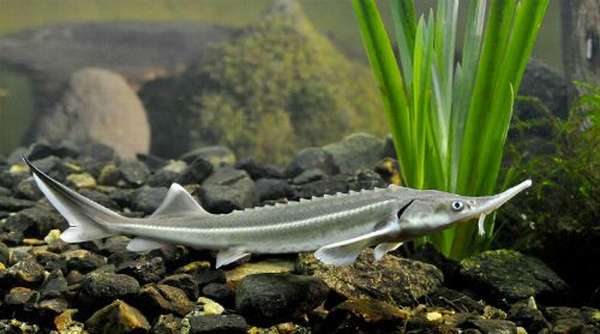
2.Shape and size of the head. You can distinguish a sturgeon by its large and wide head and short nose. The sterlet's head is small, and its nose is very long and pointed, with a mustache in the form of a fringe. Such differences can be seen even in photographs of these sturgeon representatives.
3.Color and body structure. The color of sturgeon fish can be from light gray to black, and there is practically no difference in the color of sterlet and sturgeon. But the number of lateral bony scutes (bugs) that both sturgeon and sterlet have will help to accurately determine which class the individual belongs to. The sturgeon can have up to 70 bugs, while the sterlet has 10-15 fewer scutes.
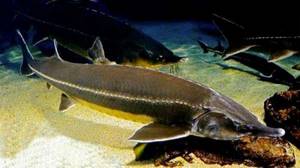
Moreover, all sturgeons belong to one of the most ancient zoological branches, which is called cartilaginous. Their main difference from other known species of fish is the absence of a bony spine, the function of which is performed by a cartilaginous chord. Fry of any type of fish have a similar structure until their skeletal system becomes stronger.
List of the most popular species and their names
Due to human intervention in the fish habitat, the demand for tasty meat, and expensive caviar, the population of the sturgeon family is sharply declining. Some representatives are listed in the Red Book. We will tell you what else is known about famous predators in the form of a list with names.
Sturgeon
The size is the third largest after beluga and kaluga. Genus of anadromous, semi-anadromous, freshwater. Dimensions reach six meters in length, 800 kg (white sturgeon). Color – shades of gray.

Sturgeon
The snout can be sharp or blunt, spatulate or cone-shaped.
Habitat:
- Black Sea
- Azov
- Caspian basin (90% of the sturgeon population)
- coast of North America
They feed on shellfish, crabs, and shrimp. Valuable commercial fish are caught for their meat, caviar, dorsal string (vizig), and swim bladders.
It is successfully kept in large aquariums equipped with powerful filtration and aeration - it loves clean water.
Beluga
There are Black Sea, Azov, and Caspian individuals.
The sturgeon giant differs in size - length up to 6 m, weight up to one and a half tons; The life cycle is about 100 years. The Adriatic beluga disappeared in the 70s of the 20th century.
The color is heterogeneous silver-brown, the belly is light. Snout without shields, short, pointed. The mouth is semicircular. The elongated body is covered with bugs, with bone plates between them.
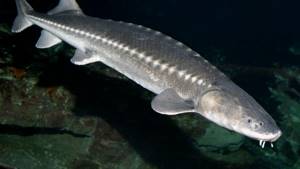
Beluga
It feeds on herring and gobies. Predators were caught with baby seals in their stomachs. Commercial fish. Meat, caviar, skin, and entrails are used. Glue for clarifying wines is made from swim bladders.
Like many sturgeons, they interbreed with other members of the family. Beluga is not kept in an aquarium; the hybrid will get comfortable in a large, unheated container.
Kaluga
The largest freshwater sturgeon is up to 5.5 m long and weighs about a ton. Life expectancy is up to 55 years. The color is gray-green, heterogeneous. The belly is lighter than the sides and back.
The snout is shortened, pointed, in the shape of a cone. The shape of the mouth is a large semicircle. The body is covered with bone plates. Lives in the Amur basin. Rarely found in the coastal zone of the Sea of Okhotsk. It feeds on chum salmon, pink salmon, and gudgeons.
There are known cases of cannibalism.
Kaluga meat and caviar are highly valued. Caught in nets. Not kept in the Aquarium.

Kaluga
Sterlet
The smallest freshwater sturgeon - length reaches 1.2 m, weight 16 kg. Lives 25 – 30 years. There are individuals of two types - with a sharp or blunt snout. The color is modified in accordance with the habitat.
Most often the back is silvery-brown and the belly is light yellow. They feed on mollusks, insect larvae, leeches, and small fish.
Distributed in the basins of the Black, Azov, and Caspian seas. Found in the rivers: Ob, Yenisei, Amur, Volga, Don and others.
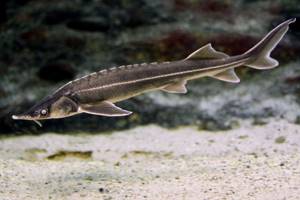
Sterlet
Artificially bred in lakes and ponds. Commercial fish. The species is included in the International Red Book. Keep in aquariums with clean running water without plants. It grows slowly.
Stellate sturgeon
Stellate sturgeon is not picky about food.
The representative with the longest snout is flattened (about 60% of the head size). Mustache without fringe. The body is covered with rows of bugs and star-shaped plates.
Deep-sea inhabitant of the Black Sea, Caspian, and Azov basins. They descend to a depth of 100 m. Length no more than 2 m, weight less than 80 kg.
Feeds:
- herring
- bulls
- crabs
- shellfish
- worms
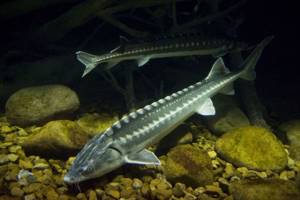
Stellate sturgeon
Fishing is prohibited, but this does not stop poachers. Meat, caviar, and fish entrails are prized. About 90% of stellate sturgeon is the result of industrial reproduction.
Kept in a large aquarium with running water.
Most representatives of the ancient sturgeon family are on the verge of extinction. Endangered large underwater inhabitants are hunted in huge quantities to satisfy human needs. Some species are bred artificially - in factories, in aquariums.
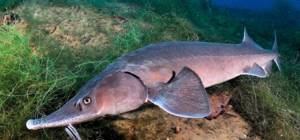
Sturgeon species of fish are distinguished by the fact that they live in salty, sea water, and go to fresh water rivers or other bodies of water to spawn. At the same time, it should be noted that sturgeons have representatives of small sizes, from 30 to 100 cm in length and weighing from half a kilogram to 5 kg, as well as representatives that grow up to 10 meters in length, weighing about 3 tons. Catching sturgeon species in our time is a serious fishery, reaching large volumes. Because of this, the population of these fish species is constantly decreasing, and some of the species are prohibited from being caught at all. Sturgeon are valued for their tasty and valuable meat, as well as caviar.
Habitat and gastronomic properties
These are two classes of sturgeon fish that are similar in appearance, but significantly different in their habitat and feeding method. Sterlet prefers to lead a sedentary lifestyle in the bottom part of clean flowing water bodies, feeding on larvae, zooplankton and small fish. The sturgeon can migrate long distances; during the spawning period it goes to sea; its food is based on fish, aquatic worms, crustaceans and shrimp. Therefore, the taste properties of sterlet and sturgeon meat have certain differences. A true gourmet can easily distinguish them by taste.
- Gastronomic properties. The main taste differences between these representatives of the sturgeon family are that sterlet meat is very tender and quite fatty (up to 30% fat). Sturgeon has a denser and more fibrous meat structure, and its fat content exceeds 15%.
- Caviar. The most valuable product that sterlet and sturgeon provide is caviar of the highest quality, and it can be distinguished by size and color. Sterlet caviar is smaller, dark, very rich in color. Sturgeon caviar is much larger and has a greenish tint.
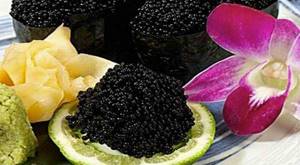
The difference between sterlet and sturgeon is quite noticeable, despite the fact that visually they have certain similarities. But at the same time, both representatives of sturgeon are considered not only a very expensive and delicious type of fish, but also a product that contains a large amount of substances and microelements useful for the human body.
Sterlet: description of composition
Sterlet is a unique product because, unlike many others, it contains no carbohydrates . That is why it can be eaten even with diabetes. This product belongs to the protein , since on average it contains about 17.5 percent protein. This is a complete protein containing amino acids that are found only in food and cannot be produced by the body on its own.
It is curious that the amount of protein in sterlet can vary depending on the season and place of catch. For example:
- Volga sterlet, depending on the time of year, can contain from 18 to 18.6% protein;
- fish from northeastern rivers have from 10.5 to 15% protein.
As for fat, sterlet is a product of medium fat content . The amount can fluctuate even more than the amount of protein for similar reasons. The minimum fat content is observed after spawning and is about 5.9 percent; by autumn frosts, fat accumulates and reaches its maximum level - up to 6.5 percent.
Fat is distributed unevenly in the carcass. There is more of it in the abdomen and a minimum in the back. When cutting sterlet, waste is produced; the maximum amount of fat is contained in the head and liver.
How to distinguish sterlet from sturgeon
The sturgeon genus has existed on planet Earth for many millennia and belongs to the elite class of commercial fish. Gourmet dishes for the preparation of which sturgeon was used were at all times considered a decoration for the festive tables of pharaohs, kings, and emperors. Sterlet and sturgeon are considered the most famous varieties of this delicious fish among modern consumers. Both representatives of sturgeon belong to the same family, but have a certain list of differences in appearance and taste.
Biological differences between sterlet and sturgeon
In addition to belonging to different classes, there are a number of biological characteristics of sturgeon and sterlet that help to understand the difference between these two representatives of the same genus.
1.Size of the individual. Most fish of the sturgeon family are impressive in size (up to 6 meters in length) and gain a lot of weight (more than 100 kilograms). Sterlet is an exception in this series. The length of an adult fish rarely exceeds 125 centimeters, and the maximum weight is 6 kilograms.
2.Shape and size of the head. You can distinguish a sturgeon by its large and wide head and short nose. The sterlet's head is small, and its nose is very long and pointed, with a mustache in the form of a fringe. Such differences can be seen even in photographs of these sturgeon representatives.
3.Color and body structure. The color of sturgeon fish can be from light gray to black, and there is practically no difference in the color of sterlet and sturgeon. But the number of lateral bony scutes (bugs) that both sturgeon and sterlet have will help to accurately determine which class the individual belongs to. The sturgeon can have up to 70 bugs, while the sterlet has 10-15 fewer scutes.
Moreover, all sturgeons belong to one of the most ancient zoological branches, which is called cartilaginous. Their main difference from other known species of fish is the absence of a bony spine, the function of which is performed by a cartilaginous chord. Fry of any type of fish have a similar structure until their skeletal system becomes stronger.
List of sturgeon fish species with photos and names
Sturgeon occupy a special niche in fisheries. Nowadays, it is worth paying attention to some representatives of this family that are of commercial interest. The following types are considered the most popular and in demand.
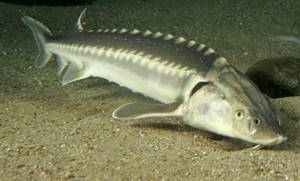
This is the oldest representative of the sturgeon family, and also the largest. Beluga can live about 100 years, growing up to 10 meters in length and gaining a weight of 3 tons. The body of the beluga is similar to a torpedo and is protected by 5 rows of protective plates. It is white below and gray above. The mouth is located at the bottom of the head and has a sickle shape. There are also whiskers that help the fish navigate in space and look for food. Females are larger in size compared to males. They lay eggs once every 2-3 years. This is a predatory fish whose diet consists of gobies, anchovies, roach, herring and other fish.

It belongs to the freshwater fish of the beluga genus and can grow up to 5 and a half meters in length and gain weight up to 1 ton. Kaluga has a relatively large mouth. There are fast-growing, estuary and migratory kaluga. To a greater extent, this fish is found in the basins of rivers such as the Amur, Sungari, Shilka and Arguni.
Russian sturgeon

This fish is distinguished by a spindle-shaped body that ends in a blunt snout. There are mustaches at the ends of the mouth. The Russian sturgeon has a white belly, gray-brown sides, and a dark gray back. It can grow up to 3 and a half meters in length and weigh up to 120 kg. Can live almost 60 years. In its natural habitat, this fish can create crosses with beluga, sterlet, stellate sturgeon and thorn. In fact, this happens very rarely, but hybrids still come across. Habitat: Black Sea, Caspian and Azov Seas.
shovelnose

It grows up to one and a half meters in length and gains weight up to 4.5 kg. It has a flat and rather long tail with bony fins. It is distinguished by a large swim bladder and small eyes. Mainly found in the Amu Darya River basin.
Siberian sturgeon

The body of this fish contains numerous bony plates and fulcra. There are no teeth, but the mouth is retractable, and in front of it there are 4 antennae. This fish inhabits the basins of rivers such as the Ob, Yenisei, Kolyma and Lena. The Siberian sturgeon lives for almost 50 years, growing up to 3 and a half meters in length and gaining a weight of about 150 kg. Spawns in July. The diet includes organisms living at the bottom of reservoirs: mollusks, chiromid larvae and polychaete worms. In other words, this fish leads a bottom-dwelling lifestyle.
Thorn

It has a classic appearance typical for sturgeon. There are 5 rows of bone spikes on the body. Habitats: the basins of the Aral, Caspian, Azov and Black seas.

The habitat is common with such a representative of the sturgeon family as thorn. At the same time, a distinction is made between spring and winter stellate sturgeon. Characteristic features of the body structure are: a poorly developed lower jaw, a convex forehead, a long nose, a smooth and thin mustache. Almost the entire body is covered with protective bone plates. The belly of the sturgeon is white, and the sides and back are blue-black. It can grow up to 6 meters in length and weigh about 60 kg.

This is the smallest representative of this family, as it grows no more than 120 cm in length and weighs 20 kg. The fish is distinguished by the presence of long whiskers that reach the mouth and a narrow but elongated nose. At the same time, the lower lip is divided into 2 parts, and on the sides the body is covered with solid scutes. The same shields protect the fish from the back. Depending on its habitat, the sterlet can differ in different colors, although its main coloring is a yellow-white belly and a gray-brown back. All fins have a gray tint. There are sharp-nosed and blunt-nosed sterlet. Habitat: northern regions of Siberia.
Habitat and gastronomic properties
These are two classes of sturgeon fish that are similar in appearance, but significantly different in their habitat and feeding method. Sterlet prefers to lead a sedentary lifestyle in the bottom part of clean flowing water bodies, feeding on larvae, zooplankton and small fish. The sturgeon can migrate long distances; during the spawning period it goes to sea; its food is based on fish, aquatic worms, crustaceans and shrimp. Therefore, the taste properties of sterlet and sturgeon meat have certain differences. A true gourmet can easily distinguish them by taste.
- Gastronomic properties. The main taste differences between these representatives of the sturgeon family are that sterlet meat is very tender and quite fatty (up to 30% fat). Sturgeon has a denser and more fibrous meat structure, and its fat content exceeds 15%.
- Caviar. The most valuable product that sterlet and sturgeon provide is caviar of the highest quality, and it can be distinguished by size and color. Sterlet caviar is smaller, dark, very rich in color. Sturgeon caviar is much larger and has a greenish tint.
The difference between sterlet and sturgeon is quite noticeable, despite the fact that visually they have certain similarities. But at the same time, both representatives of sturgeon are considered not only a very expensive and delicious type of fish, but also a product that contains a large amount of substances and microelements useful for the human body.
Useful properties of sterlet
This fish is not only very tasty, but also incredibly healthy for the body. Naturally, you need to eat it correctly and within reasonable limits so that it can benefit the body.
Know the following:
- Sterlet contains a lot of protein, which is easy to digest and contains many important amino acids. If a person starts eating it, he will not lack amino acids;
- There is little connective tissue in sturgeon. Therefore, they are easier to digest and absorb than meat and other protein products;
- Sterlet contains a lot of omega-6 and omega-3 fatty acids, which act as cholesterol antagonists.
Sterlet and other sturgeon are considered the most delicious and healthy varieties of fish. They belong to the red delicacy varieties, and the fish meat does not necessarily have to be red.
It is also worth noting that a number of religions that prohibit the consumption of meat and milk allow the consumption of fish. Fish is also a dish that can be eaten during fasting.
What is the difference between sturgeon and sterlet? Similarities and differences
In Rus', not a single royal feast was complete without exquisite sturgeon dishes. The fish were delivered to the court of the rulers in troughs hollowed out of oak trunks, laid out with damp rags in order to deliver them alive to the sovereign. For the most important festive tables, the powers prepared aspic and sterlet fish soup, and huge sturgeon baked with vegetables were the main decoration of the feasts. People who from generation to generation were engaged in catching this noble fish often never tried it in their entire lives, because it cost a lot of money, and all fishing was strictly controlled.

Today, the volume of catch of this fish has decreased critically, and it has not become more accessible to the general public. However, if desired, some sturgeon fish can be found on sale. But distinguishing them from one another is a more serious task. For example, how many people know the difference between sturgeon and sterlet? The answer to this question is not as complicated as it might seem at first glance. In order to determine who is who, it is enough to know the main differences - then even at first glance you will be able to accurately determine what kind of strange fish is in front of you.
How to eat sterlet correctly for weight loss
Many people who lead a sedentary lifestyle suffer from excess weight. And inactivity is not the only reason; the fact is that few people eat properly.
Now there are a large number of different diets, and the fish diet is very popular. It lies in the fact that fish is the main component of most dishes.
Since sterlet (especially spring-caught Volga) contains a lot of protein and some fat, it can be included in the diet when following a fish diet. Its calorie content will be even lower if you eat boiled fish.
The fish diet has these rules::
- recipes for dishes containing meat must be prepared so that it can be replaced with fish;
- increase your water intake;
- eat small meals 5-6 times a day.
Since sterlet does not contain carbon, it can be eaten even if you follow the well-known Kremlin diet.
Common features of all sturgeons
Representatives of the family are large in size. This point will help you understand the difference between sturgeon and sterlet. Sturgeon fish has tender white meat with low fat content and few bones. And their caviar is considered one of the most valuable delicacies all over the world.
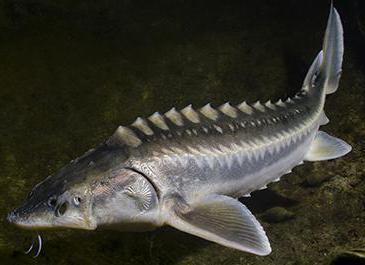
Sturgeons live in rivers, many of them love to travel, and periodically go to the seas. This is due to the characteristics of spawning. In this regard, sterlet is an exception; it is a homebody fish.
River fish or sea fish
River breeds of sturgeon are common in freshwater sea and river zones - the Baltic, Caspian, Ob-Irtysh, Yenisei, Northern Dvina and Black Sea. Among other sturgeons, the sterlet is easily recognized by its not very large size - 40-60 cm in length with a weight of up to 2 kg and an elongated nose with long antennae. Some specimens reach a weight of 6 to 16 kg, they are even confused with the Amur sturgeon, but such large individuals are found in the eastern and northern regions of Siberian rivers, and southern breeds rarely reach a weight of 1 kg.
Close relatives of the sterlet, sturgeon, are capable of migrating to brackish river deltas adjacent to the seas and remaining there for a long time. But sterlet is very selective in the taste of water and is found exclusively in fresh waters. It chooses the deepest places, stays close to the bottom, and only comes out to the shallow sands in the evening to hunt.
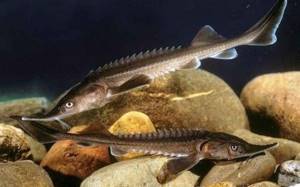
The breed's favorite conditions are cool, clear water with fast currents. It avoids slow-flowing, shallow and silt-filled rivers; it can look exclusively in search of food, but never stops in such places to spawn.
The fish live in schools and migrate from early spring to late autumn. They spawn in May and spend the winter in pits - the deepest and warmest water layers, in the lower reaches of rivers, descending to a depth of 25 m.
River sterlet fry develop very quickly until sexual maturity, which occurs from 4 years in males and from 7 years in females. They live up to 30 years. These freshwater representatives of the sturgeon genus feed on invertebrate water inhabitants - gammarids, mysids, chironomid larvae, and small mollusks. In the evenings, in shallow water, you can watch fish jumping into the air - hunting for insects.
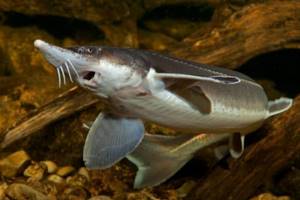
When size matters
Have you ever seen photographs of a beluga? This fish belongs to the Sturgeon family and is one of the largest on the planet, reaching several meters in length. But the sterlet can be called a champion in terms of anti-record. It is the smallest in the family, its length rarely reaches a meter. The largest specimens caught reached approximately 125 cm. Sterlet weighs about 3-5 kilograms. When asked how sterlet differs from sturgeon, you can safely answer: “First of all, size.” All other members of the family are larger than sterlet.
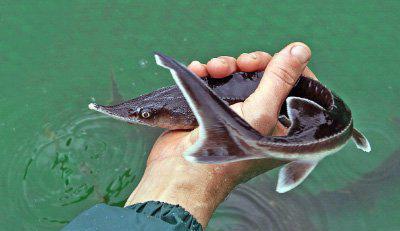
Sterlet harm and contraindications
There are no relative contraindications to eating sterlet. Therefore, the main contraindication for now remains individual intolerance to the meat of this fish.
In large quantities, especially during exacerbation, it is not recommended to consume this fish for people with diseases of the pancreas and adrenal glands. She's still a fatty fish.
Not fresh fish can become a source of botulism. Also, you should not use “Liquid Smoke” for smoking it. It is a strong carcinogen.
Salted sterlet should be used with caution by people suffering from high blood pressure.
Features of the structure of the head
The shape of the head and nose is the next characteristic feature, by which one can also determine how the sturgeon differs from the sterlet. The photo will help you see the differences clearly. Take a closer look: the sterlet’s nose is long and pointed, its head is narrow and small compared to its body. In addition, this fish has fringed whiskers.
For most sturgeons, everything is different: the nose is shorter, the head is larger and wider. Fishermen also say that the sterlet has a special look, as if surprised or naive. The sturgeon looks differently - as if more confident. Of course, we are not talking about character and not about the fact that you can read a fish’s thoughts by looking at them. This phenomenon is due solely to the structural features of the skull.
Sterlet as a medicine
Diseases of the cardiovascular system are the most common cause of death in people over 50 years of age. They are often a consequence of systemic atherosclerosis, which occurs due to a disorder in cholesterol metabolism.
Sterlet contains polyunsaturated fatty acids , including omega-3 and omega-6 . They not only improve metabolic processes in the body, but also act as protection against cholesterol .
If you eat polyunsaturated fatty acids along with fish, the formation of atherosclerotic plaques slows down and the level of cholesterol in the blood decreases. It is safe to say that eating sterlet is a good prevention of many cardiovascular diseases.
also increases the level of serotonin in the blood (a natural antidepressant). It is recommended to eat this fish during depression.
Fish meat contains large amounts of iodine , a deficiency of which can cause disruption of the thyroid gland.
Body color and structure
Sturgeon species include several breeds that are very similar to each other. You should not rely on color when trying to determine the difference between sturgeon and sterlet. What is the difference in color of these fish? All sturgeon, including sterlet, are gray in color, ranging from light to almost black.
But counting the side bugs - special bone scutes - can help you. Sterlet has more of them than other sturgeons. There can be up to 70 bugs, but the sturgeon has only 50. The dorsal spines of the sterlet are crowned with sharp spines. The body of the sturgeon is smoother. This noble fish is clearly visible in the next photo.

Lifestyle
Some sturgeon lead some incredible lives. For example, the beluga leaves the sea to spawn in the rivers flowing into it, covering a many-kilometer path. Sturgeon also likes to “walk”, but sterlet is a sedentary fish. She lives in clean running water, leads a bottom-dwelling lifestyle, but also rises to the surface in order to hunt unwary insects. Like all Sturgeons, the sterlet is a predator. She eats larvae, worms, small fish, and eggs of other underwater inhabitants. Although the sterlet is not particularly fond of travel, it also happens to swim into lakes. She behaves there even more carefully than in her native river, continues to hunt, but will never spawn.
You can distinguish these fish from each other by their eggs. Sterlet, as we already know, is relatively small, therefore, it contains less caviar. It has a rich color, and the grains are the size of beads. The slightly greenish sturgeon caviar is larger.
Do you know the difference between sturgeon and sterlet in taste? Sturgeon meat is somewhat dry, its fat content is 15%. Sterlet has fattier meat, and the taste is more tender and delicate. Its fat content reaches 30%. True gourmets believe that sterlet tastes better. Usually fish soup and aspic are prepared from it, but it is also suitable for other dishes. Sturgeon is also very valuable; its delicacies are served in the best fish restaurants around the world. Sturgeon baked whole looks especially impressive. As in the old days, it is served on the occasion of the most significant events.
Sterlet fish soup recipe
The taste of this fish is so incredible that it is almost impossible to spoil dishes based on it.
There are a large number of recipes for sterlet dishes; you need to choose depending on your diet, and also try to prepare dishes that highlight the taste of the fish itself. For example, it will be incredibly tasty and aromatic if it is stewed in wine and served with onions and tomatoes. And as a side dish you can serve boiled potatoes or vegetables.
As for fish soup based on sterlet, it is a traditional dish of Russian “royal” cuisine and part of the national flavor. To prepare it you will need the following ingredients:
- fish – 0.5 kg;
- any freshwater small fish – 1 kg;
- onion - one medium head;
- carrots – 2 medium pieces;
- celery root and parsley - each;
- potatoes - 5 medium pieces;
- rice - 4 large spoons.
The preparation looks like this:
- cut parsley, celery and carrots or grate them on a coarse grater. Pour 3 liters of cold water;
- We wrap small fish in canvas or gauze and set to cook;
- when the broth boils, skim off the foam and add peppercorns and bay leaves;
- when you get fat from small fish, remove it from the broth;
- cut the potatoes and put them in a saucepan;
- add rice, salt, boil and cook over medium heat for about 10 minutes;
- cut the sterlet into portions and place in a saucepan. Cook for about 15 more minutes.
